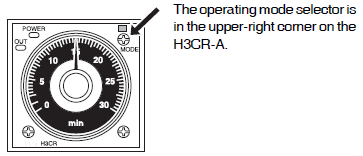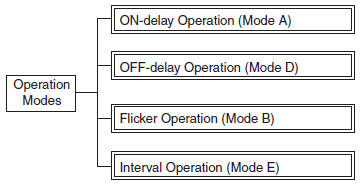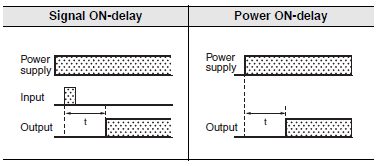Timers
OMRON provides a range of Analog Timers and Digital Timers, as well as Time Switches for 24-hour, weekly, or annual time control.
| Introduction | Features |
| Principles |
|
| Engineering Data |
|
|
|
|
-
 What is a Timer?
What is a Timer?
-
 Settings and Indications of Timers
Settings and Indications of Timers
-
 Operating Modes of Timers
Operating Modes of Timers
-
 What Is a Time Switch?
What Is a Time Switch?
-
 Settings and Indications of Time Switches
Settings and Indications of Time Switches
-
 Operating Modes of Time Switches
Operating Modes of Time Switches
What is a Timer?
A timer is a control device that outputs a signal at a preset time after an input signal is received.

Settings and Indications of Timers
Example for the H3CR-A
Settings

(1) Time setting knob
(2) Time unit selector
(3) Time range selector
(4)Operating mode selector
[Note] A variety of time ranges can be set with the H3CR-A using the time unit selector and time range selector.
Indications
The pointers on the Timer do not move along with time like the hands of a clock do. You cannot see the progression of time.
Therefore, two operation indicators are provided on the upper left of the Timer to identify the timer status.
(5) Run/Power Indicator (Green)
Run indicator: Indicates whether the time is being measured or the time has reached.
Power indicator: Indicates whether power is being supplied to the Timer.
Fundamentally, the indicators will be lit when the power is being supplied. However, they will flash when the time is being measured.
(6) Output Indicator (Orange)
Used to see the status of the output. Lit when a signal is output.
Operating Modes of Timers

The operating mode determines the output method that is used when the set time has reached.
The following four basic operating modes are the most commonly used.


With ON-delay operation, the Timer receives an input and then an output signal is output by switching the Timer contacts after a set time delay.
This name is used because there is a delay between when the input signal is received (i.e., turns ON) and when the output signal is output.
ON-delay operation is the operating mode most often used for automated machines.
Application: Pushbutton Signals

When the pedestrian pushbutton is pressed for a traffic signal, the signal light changes from red to green after a delay.
OFF-delay Operation

With OFF-delay operation, the output turns ON at the same time as the input and then the output turns OFF when the Timer contacts switch after the set time has expired. The set
time is calculated from when the input turns OFF.
This name is used because there is a delay between when the input turns OFF and when the output turns OFF.
Application: Car Ceiling Lights

When you get in your car, the ceiling light turns ON when the door is opened. The light remains lit for several seconds after you get into the car and close the door.

With flicker operation, an output repeatedly turns ON and OFF at the set time after an input is received.
Application: Automatic Control of Fountains

The water is repeatedly released and stopped at intervals of two minutes.

With interval operation, the output turns ON at the same timeas the input and the output turns OFF after a set time.
Application: Amusement Park Rides

The ride operates for five minutes when 100 yen is inserted.
Timer Starting Methods
There are two starting methods for the operating modes.
Example: ON-delay Operation
Signal ON-delay operation: Measuring time starts when the input section receives an input while voltage is being applied to the Timer power supply section.
Power ON-delay operation: Measuring time starts when voltage is applied to the Timer power supply section.

Differences between Signal ON-delay Operation and Power ON-delay Operation
(1) Accuracy*
Operation will not be stable unless a brief period elapses after the power supply is turned ON to the timing section of the Timer.
Power supply start:Operation is unstable because measuring time starts at the same time that the power supply turns ON.
Therefore, deviation will occur in the operation time immediately after starting the Timer.
Signal start: Stable time accuracy is ensured because a voltage is already applied to the Timer before starting the Timer.
The accuracy of the signal start is generally considered better. For some models, however, such as the H3CR, there is no change in accuracy.
*Accuracy is the correctness of the time.
(2) Terminal Arrangement

• Models with a signal start require three external inputs, so they have many terminals.
• Models with a power supply start (H3CR-A8) are the H3CR Timers most often used for automated machinery.
What Is a Time Switch?
A Time Switch is a control device that turns a load ON and OFF at the set times.

However, most models of Time Switches do not have an input section.
If there is an input section, it is not used to output signals to the timing section, ather, it is used to control some of the functions of the Time Switch, such as adjusting the time.
Settings and Indications of Time Switches
Example for the H5F

| No. | Function |
| (1) | Switches between time adjustment mode, the operation setting modes, and run mode. |
| (2) | Sets hours or switches between 12-hour (am/pm) and 24-hour display. |
| (3) | Sets minutes or a pulse time width. |
| (4) | Writes the set data to memory or confirms settings with the program check function. |
| (5) | Moves the cursor to specify a day or starts the program check function. |
| (6) | Specifies or cancels a specified day or switches to holiday setting mode. |
| (7) | Deletes the set data and initializes the day of operation or sets/clears summer time. |
| (8) | ON: Turns on the output regardless of the setting. AUTO: Turns on/off the output according to the setting. OFF: Turns off the output regardless of the setting. Override and automatic return operation can be executed by using this key in combination with the Write Key. |
| (9) | Selects timer operation or pulse-output operation. |
Operating Modes of Time Switches
The operating mode determines the ON/OFF output method that is used for the set times.

Timer Operation (ON/OFF Operation)

With timer operation, the Time Switch controls the output according to the set ON and OFF times.
Application 1: Warm-up Operation for Packing Machine

The packing machine can be warmed up before the employees come to work so that work can begin immediately.
Application 2: School Chimes

The chimes can be sounded at the start of classes, at the lunch break, and at the end of classes.
Pulse-output Operation

With pulse-output operation, the Time Switch outputs a pulse of a specified time width at the set ON time.
Forced ON/OFF Operation
Forced ON/OFF Operation is used to force the output ON or OFF by using the output ON/OFF switch regardless of the control output setting.
Override and Automatic Return Operation

With override and automatic return operation, the output ON/OFF switch and the Write Key are used to hold the control output ON until the next OFF time.
Partial Operation on Specified Day

You can select days on which to execute only part of the set operations.
Holiday Setting

It is possible to set an operation day in the present week as a holiday (i.e., a non-operation day: output will be OFF regardless of the settings). When that day has passed, operation will continue according to the regular program, and operation will be executed as normal on that day from the following week.
Time Switch Starting Methods
With a Time Switch, the progression of time starts when a voltage is applied to the power supply section.
* When the power supply section is OFF, time progresses and the settings are retained, but no operations are performed to turn the output ON or OFF.
Terminal Arrangement
Example for the H5F-A/B
